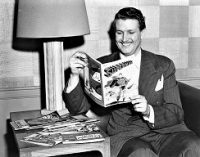
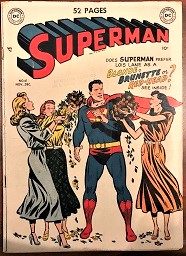 The Adventures of Superman (1940-1951) aired “The Puzzle of the Poison Pomegranate” on November 26, 1949 as the 5th episode of its ABC run in the late 1949–early 1950 season (all of which were of the half hour variety as opposed to the many multi-part, 15-minute serials that ran through most of the 1940s). Since we’ve showcased only two other episodes of this program (in April of this year, 2021, and October of 2020) I felt it would be helpful for newcomers to this fun adventure series if I reprised the generic background information that preceded those other episodes.
The Adventures of Superman (1940-1951) aired “The Puzzle of the Poison Pomegranate” on November 26, 1949 as the 5th episode of its ABC run in the late 1949–early 1950 season (all of which were of the half hour variety as opposed to the many multi-part, 15-minute serials that ran through most of the 1940s). Since we’ve showcased only two other episodes of this program (in April of this year, 2021, and October of 2020) I felt it would be helpful for newcomers to this fun adventure series if I reprised the generic background information that preceded those other episodes.
(Cover above left: Superman #61, Nov.-Dec. 1949, featuring Lois Lane, also coincidentally featured in this week’s OTR episode.)
The Superman character, created by Jerry Siegel and Joe Shuster, first appeared in Action Comics #1, dated June 1938. That superhero strip in the comic was one of several strips in that now famous first issue, but turned out to be popular enough that a newspaper comic strip debuted in 1939. It also proved immensely popular, popular enough that a stand alone comic book was spun off and added to the ever-growing franchise, with the now iconic title of Superman #1, with a cover date of Summer 1939 (cover below left).
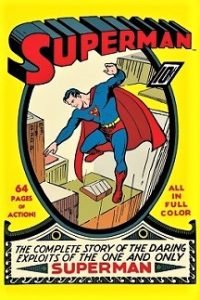 But the comic strip and magazine were only the beginning for the Man of Steel. Things were moving quickly, and as Wikipedia explains: “The serial came to radio as a syndicated show on New York City’s WOR on February 12, 1940. On Mutual, it was broadcast from August 31, 1942, to February 4, 1949, as a 15-minute serial, running three or, usually, five times a week. From February 7 to June 24, 1949, it ran as a thrice-weekly half-hour show. The series shifted to ABC Saturday evenings on October 29, 1949, and then returned to afternoons twice a week on June 5, 1950, continuing on ABC until March 1, 1951. In all, 2,088 original episodes of The Adventures of Superman aired on American radio.” Wikipedia also notes that many of the elements that have become staples of Superman’s fictional world were first introduced in the radio show, among them kryptonite, Daily Planet editor Perry White, copy boy (later cub reporter) Jimmy Olsen, and police inspector Bill Henderson. Also worthy of mention is the first meeting between Superman and Batman (and Robin) which took place in the March 2, 1945 episode.
But the comic strip and magazine were only the beginning for the Man of Steel. Things were moving quickly, and as Wikipedia explains: “The serial came to radio as a syndicated show on New York City’s WOR on February 12, 1940. On Mutual, it was broadcast from August 31, 1942, to February 4, 1949, as a 15-minute serial, running three or, usually, five times a week. From February 7 to June 24, 1949, it ran as a thrice-weekly half-hour show. The series shifted to ABC Saturday evenings on October 29, 1949, and then returned to afternoons twice a week on June 5, 1950, continuing on ABC until March 1, 1951. In all, 2,088 original episodes of The Adventures of Superman aired on American radio.” Wikipedia also notes that many of the elements that have become staples of Superman’s fictional world were first introduced in the radio show, among them kryptonite, Daily Planet editor Perry White, copy boy (later cub reporter) Jimmy Olsen, and police inspector Bill Henderson. Also worthy of mention is the first meeting between Superman and Batman (and Robin) which took place in the March 2, 1945 episode.
Bud Collyer (1908-1969, photo top right) was the voice of Clark Kent and Superman on radio, lowering his voice slightly when speaking as the Man of Steel. He is arguably best known, however, as the host of the popular television game shows of the 1950s, Beat the Clock and To Tell the Truth.
Joan Alexander (1915-2009, birth name Louise Abrass) played the spunky Lois Lane character for more than one thousand episodes of the program’s 11-year run.
From 1940-47 Jack Kelk (1923-2002) would play Jimmy Olsen, and from 1948-1950 it was Jack Grimes (1926-2009) who would play Jimmy Olsen. An interesting bit of trivia concerning Grimes is that though he was an old man of 22 when he began playing Jimmy Olsen, by the age of 12 he was acting in 35-40 radio shows a week. Grimes also worked in film and television in later years. A film of note in which he appeared was 1945’s noir crime film Lady on a Train (starring Deanna Durbin and Ralph Bellamy), based on the Leslie Charteris story. His television work included roles in Tom Corbett, Space Cadet, Maude, and All in the Family.
(Left: Joan Alexander – Center: Jack Kelk – Right: Jack Grimes)
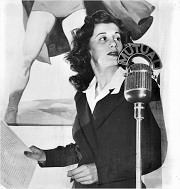


“The Puzzle of the Poison Pomegranate” opens with Lois Lane arriving for an interview at the laboratory of a famous bio-chemist on the brink of testing a newly developed antibiotic. (Modern antibiotics [aka antibacterials] had been subjects of major medical interest since Fleming’s discovery of penicillin from bread mold in 1928, so a story built around a new one was worthy subject matter.) While waiting for the scientist to appear for their interview, Lois and the scientist’s assistant hear noises and the sounds of broken glass coming from the next room, which is locked. Shortly thereafter, the room now opened, they discover the dead body of the scientist. Lois’s call to the authorities draws official attention—including police Inspector Henderson and fellow reporter Clark Kent (and therefore, Superman). The who and why of it all are the nuts and bolts of this intriguing story, with a poisoned pomegranate fruit somehow at the center of it all. But how could this be? The innocuous fruit was not poisoned prior to becoming part of the scientist’s lunch, no one else was in the room when the homicide occurred, and who had motive for killing the professor over the possible discovery of a new antibiotic, if such was even the case? Too many questions with no answers immediately forthcoming are a true test for Superman in this well-conceived mystery, so sit back and enjoy “The Puzzle of the Poison Pomegranate.”
Play Time: 29:33
{Having listened to this episode of Superman on a Saturday evening in late November of 1949, the neighborhood gang found themselves at the corner newsstand the next day after church, with orders from their parents to make it quick and be home in time for Sunday lunch (no doubt as sandwiches from the last of the Thanksgiving turkey from the previous Thursday’s feast). Fortunately, the gang found some good stuff quickly and were soon on their way home. Science fantasy seemed to be the order of the day with their selections. fantastic Adventures (1939-53) was published by controversial magazine editor Raymond A. Palmer as a companion magazine to Amazing Stories, but with “lighter” fare, though by the late 1940s it was printing much the same type of story as its elder counterpart. It was a monthly in 1949. Both Planet Stories (1939-55) and Thrilling Wonder Stories (1936-55) formed part of the informal group of SF pulps featuring fast-paced, imaginative, colorful adventure fare on imaginary worlds across time and space, and the strict adherence to science be damned. They were wildly popular among the younger male crowd, many of the most popular names in the field wrote for these gaudy pulps, and while not “high” literature by any means, are now sought as prized collector items at SF conventions in dealer/huckster rooms. Planet Stories was a quarterly in 1949, while Thrilling Wonder published bi-monthly.}
[Left: fantastic Adventures, Nov. 1949 – Center: Planet Stories, Winter 1949 – Right: TWS, Dec. 1949]
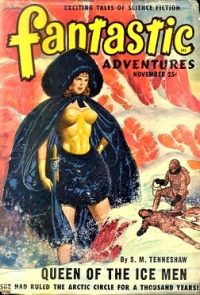
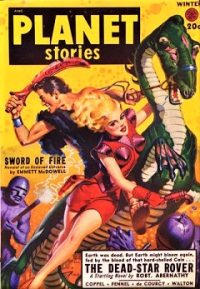
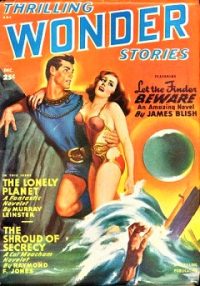
To view the entire list of weekly Old Time Radio episodes at Tangent Online, click here.